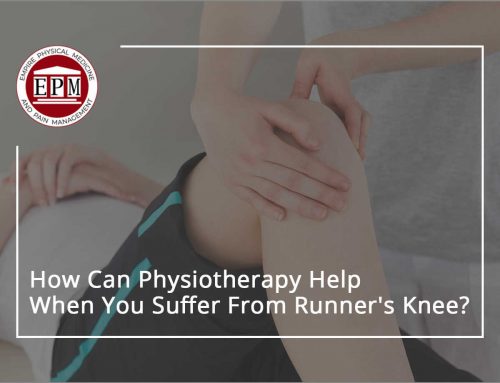Now that spring is just around the corner, the days are getting longer and the weather is starting to warm up, you may be feeling more motivated to go out for a run. Especially nowadays, nothing is more invigorating than getting out of the house for a quick jog and some fresh air.
Your hamstring is composed of three muscles, the biceps femoris, semitendinosus and semimembranosus, and runs down the back of the leg from your thigh to your knee. These group of muscles help you bend your knee and extend your hip. Hamstring pulls are a very common running injury and can occur in active individuals. They occur due to muscle overload when one or more of the muscles in the hamstring are overstretched and tear. The good news is that most cases can be treated without requiring surgery.
Who is at risk and what causes a hamstring strain?
There are several causes that can contribute to your hamstring strain. One is improper stretching. If your muscles are tight and are not warmed up, they are more susceptible to strains. Also, many of us have stronger and larger quads, which are the muscles in the front of your thigh. If you are a runner, your hamstrings are more susceptible than your quads to getting tired which places you at a higher risk of developing a strain. If your running technique is poor or you return to the gym or your activity of choice too soon without fully healing, you could also easily pull your hamstring.
You may be at risk if you are involved in activities and sports which involve a lot of high-speed running such as soccer, football and track and field. You’re also vulnerable to developing a hamstring injury if you have already had one in the past.
What are the Symptoms?
You may feel a sharp pain and you may even feel a popping sensation in the back of your leg. You will also develop tenderness, bruising or swelling in the back of your thigh.
There are three different levels of hamstring strains. If you have a grade one strain, you may have mild swelling or spasms. While you may not be able to run at full speed, you will be able to walk normally, despite feeling some tightness in the back of your thigh. A grade two injury may cause you to limp. Your hamstring may be throbbing, tender and you may notice some swelling. Pain will arise as well if you bend your knee against resistance. The most severe level is a grade three, which involves a complete tear to half or all of your hamstring muscle. With this type of injury, you will need a walking aid, such as crutches, and you will experience severe pain.
The time it takes to recover depends on the severity of the strain. Recovery make take a week to as long as six months. If you have a severe strain, a complete rupture, or a reoccurring hamstring injury, surgery may be required. While you may feel better after a few days, it is important that you have your hamstring looked at. This will enable you to rehab it correctly to prevent the buildup of scar tissue and reduce the risk of a re-injury.
Physical Therapy aims to reduce your hamstring pain and strengthen your muscles, specifically targeting the hamstrings, knees, calves, hip and pelvis muscles. This will help increase your muscle’s range of motion, improve your function and normalize the lumbo-pelvic control, which is a contributing factor in hamstring injuries.
Below, we outline some exercises and stretches to help with hamstring strains and injuries. These should only be performed if daily activities such as walking do not cause pain. If you ever feel sharp pain at any point, stop. You should only feel a mild discomfort, if at all:
Standing Hamstring Stretch
Place the heel of your injured side on the side of a chair or stool. While keeping your leg straight, lean forward while bending at your hips. You should feel a light stretch in the back of your thigh. It is important that you do not bend your knee while doing this stretch as that will target your lower back instead. Hold this for 30 seconds and repeat a few times throughout the day. The purpose of this stretch is not to increase your flexibility but to get some elasticity to the healing tissue.
Hurdler Hamstring Stretch
Sit on the floor with your left leg straight out. Bend your right leg at the knee and place your right foot on your left thigh. Reach forward with your arms over your left leg and bend your waist forward as far as possible while holding this position for ten seconds. Switch legs and repeat on the other side.
Hamstring Curl
Grab a pillow to place under your belly for support while you lie on top. Start by lying on your stomach with your legs straight out behind you. On the side with the affected leg, bend your knee so that your foot is towards your buttocks. Move your leg down slowly and back up and repeat these 10 times over. If this exercise is too easy for you, add a resistance band.
Lunge Stretch
Start off by stepping forward with your left leg. Dip your knee so that it is at a 90-degree angle. This stretch will strengthen the quads which are the muscles in the front of your thigh. Do not attempt this stretch at the beginning of your injury but rather later in your recovery when you’re feeling stronger.
Bent Knee Stretch
Lie on your back and lay one your left leg on the floor and your right leg up in the air. Clasp your fingers behind your right thigh and bring your leg closer to your chest until you feel a light stretch in the back of the leg. Hold this for ten seconds and perform this several times a day.
In addition to exercising caution, these exercises should help get you feeling better in no time. Your physical therapist may prescribe more exercises to do at home depending on the level of your injury and the progress of your recovery. For more information, call us at (646) 665-7109.
Published By:
Empire Physical Medicine & Pain Management
7 W 45th St floor 9,
New York, NY 10036
Phone: (646) 665-7109
Website: https://manhattanpainrelief.com






